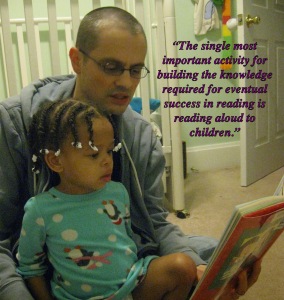An annual Father’s Day post…with updates and additions.
READING ALOUD
I read aloud to my students from the very first day I taught at an elementary school beginning in January 1976. I had caught the read-aloud bug from the late Lowell Madden, one of my Education School Professors. I had it reinforced by Jim Trelease, whose Read Aloud Handbook is a treasure of information for anyone who is interested in reading aloud to children. [I’ve referenced Jim Trelease quite a few times on this blog.]
I read aloud to all my classes because reading aloud is simply one of the best tools we have to help children learn to read. Reading is, arguably, the single most important skill a child learns in school.
Jim Trelease, in The Read Aloud Handbook reminded us [emphasis added]
In 1985, the commission [on Reading, organized by the National Academy of Education and the National Institute of Education and funded under the U.S. Department of Education] issued its report, Becoming a Nation of Readers. Among its primary findings, two simple declarations rang loud and clear:
“The single most important activity for building the knowledge required for eventual success in reading is reading aloud to children.”
The commission found conclusive evidence to support reading aloud not only in the home but also in the classroom: “It is a practice that should continue throughout the grades.”
In its wording—“the single most important activity”—the experts were saying reading aloud was more important than worksheets, homework, assessments, book reports, and flashcards. One of the cheapest, simplest, and oldest tools of teaching was being promoted as a better teaching tool than anything else in the home or classroom. What exactly is so powerful about something so simple you don’t even need a high school diploma in order to do it and how exactly does a person get better at reading? It boils down to a simple, two-part formula:
- The more you read, the better you get at it; the better you get at it, the more you like it; and the more you like it, the more you do it.
- The more you read, the more you know; and the more you know, the smarter you grow.
Reading aloud to children is an activity that entertains…it strengthens personal bonds, it informs and explains…and, according to Trelease, when you read aloud to a child you also:
- Condition the child’s brain to associate reading with pleasure
- Create background knowledge
- Build vocabulary
- Provide a reading role model
Reading aloud is more beneficial than standardized tests or worksheets. It is more important than homework or flashcards. It is the single most important thing a parent can do to help their children become better readers. It is the single most important thing teachers can do to help their students become better readers.
 |
| My collection of Read-Aloud Handbook editions, several of which have been signed by the author, Jim Trelease. |
FATHERS AND READ-ALOUD
In the latest edition of his book (2013), Trelease devotes an entire chapter to fathers and reading aloud. He focuses on fathers reading aloud to sons because fewer fathers than mothers read aloud to their children, and sons are the ones, according to statistics, whose academic achievement could use the read-aloud boost. Obviously, this does not mean that fathers should not read aloud to their daughters. The point is to get fathers to read aloud to their children.
The Read-Aloud Handbook by Jim Trelease: CHAPTER 9: Dad—What’s the score?
In case you’ve been off the planet for the past several decades, let me bring you up-to-date on our boys and their school woes.
- In a 2008 study of reading tests in forty-five states, the girls exceeded the boys at every grade level.
- Unlike four decades ago, it is now common for girls to dominate a high school’s highest academic positions (valedictorian), class leadership positions, advanced placement spaces, and school activities. While the girls are assuming responsibilities, the boys are playing sports or video games.
- For the first time in history, women exceed their male counterparts in most collegiate achievements, from enrollment and graduation to earning advanced degrees, and the gap is widening annually. About the only significant area in which males dominate in college is “dropout,” where they lead by a 3:2 ratio.
(And an excellent pamphlet with important information specifically for dads….Fathers, Sons and Reading)
Boys, Trelease says, need their fathers to read to them. The relationship between fathers and sons has changed over the years, and not necessarily in a good way. Over the last few decades, America’s “male” culture has been dominated by politics, sports, and television, and boys watch their role models carefully. Among those men in important cultural and political positions in America are abusers, racists, and misogynists. It’s more important than ever that fathers exert positive role-model influence over their sons.
The landscape of the American male’s attention span was being dramatically altered and boys were soaking up the changes.
“Is there a connection,” Trelease asks, between the “decline in boys’ interest and achievement in school and the behavior of the male culture?”
Can a father play catch in the backyard after dinner and still read to the child that same evening? Can they go to a game one day and to the library the next? You betcha.
The question is…do they? Do fathers take part in their children’s, and specifically their sons’, intellectual development? Reading aloud to your child is an easy, fun way for fathers to have a positive academic influence on their children.
Dad—what have you done for your son’s head lately?
Make a Father’s Day resolution. Read to all your kids every day.
Need more convincing? Check out the following online resources…













